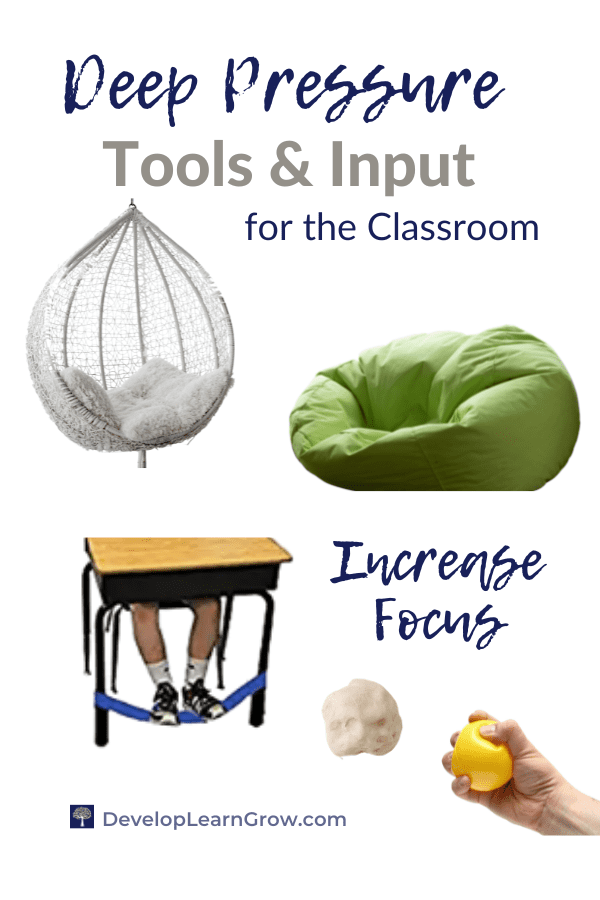Occupational therapists use deep pressure sensory activities to calm kids and to organize their nervous systems. Deep pressure tools and activities help increase focus for learning at the same time!
Helping teachers and parents use sensory strategies in the classroom and at home is a big part of my job as an occupational therapist.
In a school years ago, I worked with a second grade teacher who had a student who had extra sensory needs. This girl really needed extra deep pressure input during her learning day. She frequently sought out deep pressure touch input, and truly needed it to focus and attend and to improve her body awareness.
The teacher agreed to trial several deep pressure tools for ALL of her students so that the student i with sensory needs didn’t stand out.
We gathered items… from my agency, from her house, and from my home occupational therapy supply closet.
The teacher was great at presenting the items to the class. She rotated them strategically so that the student who needed certain sensory tools always had them! The deep pressure therapy tools were offered on a regular basis and helped the student with her sensory processing difficulties.
Sensory Tools Used in the Classroom, Sensory Room and at Home
Some of our sensory items included weighted lap pads (store bought and homemade), weighted shoulder buddies (homemade), pressure cushions for chairs, therapy balls, squeeze balls and fidget toys for the hands.
The teacher provided additional sensory information during her classroom brain breaks by using heavy work activities, deep pressure activities and movement exercises. She quickly and easily plugged them into the day during short breaks and transitions.
At home, the family gave their daughter proprioceptive input using a weighted blanket, joint compressions, and compression clothing. She participated in heavy work activities at home for the whole body and for her hands.
As part of her occupational therapy support from me, she followed a sensory diet where she had daily access to the sensory room. Her favorite sensory toys were a body sock, sensory swings (a homemade compression swing and a net swing) and compression vests.
This little girl loved the body sock so much that she would even walk through the hall in it! A school assistant also provided her with firm pressure using an exercise ball and there was a squeeze machine in the room.
Benefits of Deep Pressure Tools and Activities for Kids when Learning
Our sensory systems take in information to the muscles and joints through the proprioceptive system. Deep pressure (proprioceptive input) gives such powerful input to the brain.
The magic of this input is that it is both calming and organizing as well as alerting for the brain and central nervous system.
Deep pressure tools and activities can ease tension and anxiety by increasing relaxation. (Think of a great massage and how the deep pressure stimulation relieves stress and has a very calming effect!)
Pressure input provides stimulation through the deeper skin receptors. This input alerts the nervous system for increased attention.
Many kids (and adults) seek and need this input for their nervous systems. The proprioceptive input helps their brains focus.
Kids who need this input, need it at regular intervals throughout the day.

Calming Deep Pressure Tools, Activities & Exercises That Increase Alertness and Attention during Learning
[Affiliate links are used below. See below for more information.]
Deep pressure tools provide added input to the sensory systems that some kids bodies need in order to focus and attend. It also helps with body awareness. Proprioceptive input is a powerful tool to help increase attention and calm the central nervous system.
If you have a student who seeks deep pressure, make sure they alternate some of these sensory tools with flexible seating options that help improve their seated posture. Additionally, use core exercises during your brain breaks.
Seating Options That Provide Deep Pressure Sensory Input
- Hammock swing
- Bean bag chair
- Oversized floor pillows
- Floor pillows
- Floor rockers
- Wipe clean weighted lap pad
- Weighted lap blanket (with washable cover)
- Chair bands
- Bouncy bands
Deep Pressure Tools for the Hands
- Stress balls
- Gel filled balls
- Sand filled stretchy animals
- Putty
- Molding dough
- Resistive cubes
Activities & Exercises to Give Deep Pressure Input to the Body
During brain breaks, kids can give quick deep pressure massage input to themselves. I often say “we have to get your body ready for learning.”
For example, have kids:
- Squeeze and massage shoulders all the way down the arms to their wrists. (This is also great for crossing midline!)
- Massage the hands, include squeezing each finger all the way down to the tips. Add an extra squeeze to each knuckle and the fingertips.
- “Give yourselves bear hugs” and count to 10.
- Push hands together for a count of 10.
- Lean into their desk to press against their palms.
- Make a fist and squeeze the fisted hand with the opposite hand. Repeat other side.
Additional proprioceptive activities are listed in 25 Proprioceptive Brain Breaks for Kids: Improve Focus and Attention. (A free printable is available, check out the post for more helpful information.)
For More Calming and Organizing Sensory Strategies That Improve Focus in Kids, Be Sure to Read:
- Wake the Brain with Proven Oral Sensory Tools and Activities – Check out the power of using sensory tools for the mouth and oral motor and oral sensory activities. Very calming and organizing for the nervous system.
- Glitter Art – A Skill Building Craft with a Twist! – An oral sensory approach to making a craft. This is a kid favorite!
- Flexible Seating in the Classroom – Occupational therapy and kid approved seating options that provide input to the sensory systems, but also improve seated posture.

Challenges Obtaining Calming Deep Pressure Tools
When I first started working in the schools (early 2000’s), occupational therapists were able to buy $500 worth of supplies per school year.
Teachers were also given spending allotments for their special needs students and special education classroom.
Then budget cuts happened. And happened again…
They eventually disappeared and we have all been left on our own to purchase what we needed. Many of us had to stop buying some of the more pricey sensory tools that helped the students focus better.
I’ve had to get creative over the years by making my own supplies or buying them myself.
Luckily, I had some schools that were able to express the need to parent or community groups. They would use fundraising money or donations to purchase needed sensory toys for the classrooms.
With more awareness of different learning needs in all students, schools and communities are more willing to help provide classrooms and schools with tools for the sensory systems.
Currently, I have a lot of teachers that place toys, games and sensory items on their Amazon Wishlist. Parents and community members often purchase what is needed! My sister has a list for her third grade classroom. She has added many occupational therapy activities for her students’ morning work, free time, or for indoor recess. (Many of the ideas I gave her came from Learning Centers for the Classroom and the Visual Motor Activity Using Magnets blog posts.
When to Seek Help from an Occupational Therapist for Kids with Sensory Processing Difficulties
Many kids that have sensory processing difficulties and seek sensory input might not need occupational therapy support. Their sensory needs may not significantly interfere with their day to day functioning and learning. You can fully support the child’s needs with some basic awareness of the sensory systems, use of simple sensory strategies, and knowledge of helpful sensory tools.
Minor sensory difficulties can be as simple as a child experiencing sensory overload who might just need a quiet spot or a break from the classroom. If you have a movement seeker, incorporate more movement activities into the day. For those kids seeking deep pressure sensation, allow them to lie on the floor, sit on their knee, or wrap their feet around the legs of the chair. Be flexible and patient and know that all of their nervous systems are still developing and need sensory input.
Seeking Help for Sensory Processing Disorder
Sensory processing disorder encompasses difficulties with sensory modulation, sensory discrimination and sensory-based motor disorders. Consider if the sensory difficulties cause frequent disruption to daily routines, severe difficulty learning, or turn into behavioral problems. When difficulties with the sensory systems are severe, then support from an occupational therapist should be sought out. Reach out for ideas to try for a few months then consider an occupational therapy screen to determine if an occupational therapy evaluation is necessary.
School-based occupational therapy can support an educational team in creating a sensory diet for a student. Further sensory integration therapy can be provided in an outpatient setting for students with severe sensory processing disorder.
[Amazon affiliate links are used in this post. Develop Learn Grow may earn a very small commission if you click on a link and make a qualifying purchase. See full disclaimer and privacy policy for additional information.]
Editor’s note: this post has been updated from its original content for a better reader experience.



0 Comments